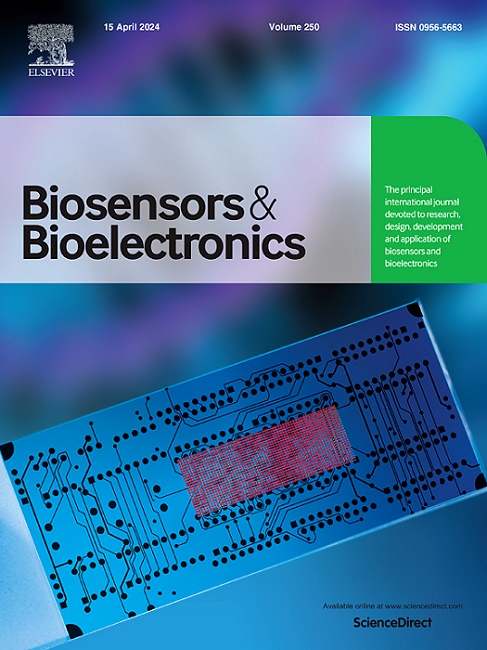Wearable electrochemical aptasensor based on MXene@gold nanoparticles for non-invasive sweat cortisol detection
IF 10.5
1区 生物学
Q1 BIOPHYSICS
引用次数: 0
Abstract
Chronic stress exerts detrimental effects on both physical and mental wellbeing, thereby necessitating the quantitative and real-time monitoring of stress biomarkers, such as cortisol. To address this, a non-invasive, wearable electrochemical aptasensor based on MXene and gold nanoparticles (Mxene/AuNPs) modified screen-printed electrodes (SPEs) is proposed to detect cortisol in human sweat. Conformationally altered aptamers, with methylene blue (MB) as an electrochemical indicator, are linked to AuNPs via gold-sulfur bonds to capture cortisol. Mxene/AuNPs not only increase the specific surface area of the working electrode but also facilitate the immobilization of the aptamer. Moreover, an integrated microfluidic sampler is integrated with this aptasensor to ensure efficient sweat collection, which could effectively prevent sweat evaporation and contamination. Finally, the performance of this aptasensor is evaluated through the differential pulse voltammetry (DPV) technique, exhibiting high specificity ranging from 0.5 to 500 ng/ml (1.38–1379 nM) with a low detection limit of 0.1 ng/ml. This work demonstrates a practical strategy for developing cost-effective and scalable wearable sensors for sweat-based biomarker detection.
基于MXene@gold纳米颗粒的可穿戴电化学感应传感器用于无创汗液皮质醇检测
慢性压力对身心健康都有不利影响,因此有必要对压力生物标志物(如皮质醇)进行定量和实时监测。为了解决这一问题,研究人员提出了一种基于MXene和金纳米颗粒(MXene /AuNPs)修饰的丝网印刷电极(spe)的无创、可穿戴电化学适体传感器,用于检测人体汗液中的皮质醇。构象改变的适体,以亚甲基蓝(MB)作为电化学指示剂,通过金-硫键与aunp连接以捕获皮质醇。Mxene/AuNPs不仅增加了工作电极的比表面积,而且有利于适配体的固定化。此外,该传感器集成了微流控采样器,确保高效的汗液采集,有效防止汗液蒸发和污染。最后,通过差分脉冲伏安法(DPV)技术对该传感器的性能进行了评估,显示出高特异性范围为0.5至500 ng/ml (1.38-1379 nM),低检测限为0.1 ng/ml。这项工作展示了一种实用的策略,可以开发成本效益高、可扩展的可穿戴传感器,用于基于汗液的生物标志物检测。
本文章由计算机程序翻译,如有差异,请以英文原文为准。
求助全文
约1分钟内获得全文
求助全文
来源期刊

Biosensors and Bioelectronics
工程技术-电化学
CiteScore
20.80
自引率
7.10%
发文量
1006
审稿时长
29 days
期刊介绍:
Biosensors & Bioelectronics, along with its open access companion journal Biosensors & Bioelectronics: X, is the leading international publication in the field of biosensors and bioelectronics. It covers research, design, development, and application of biosensors, which are analytical devices incorporating biological materials with physicochemical transducers. These devices, including sensors, DNA chips, electronic noses, and lab-on-a-chip, produce digital signals proportional to specific analytes. Examples include immunosensors and enzyme-based biosensors, applied in various fields such as medicine, environmental monitoring, and food industry. The journal also focuses on molecular and supramolecular structures for enhancing device performance.
 求助内容:
求助内容: 应助结果提醒方式:
应助结果提醒方式:


